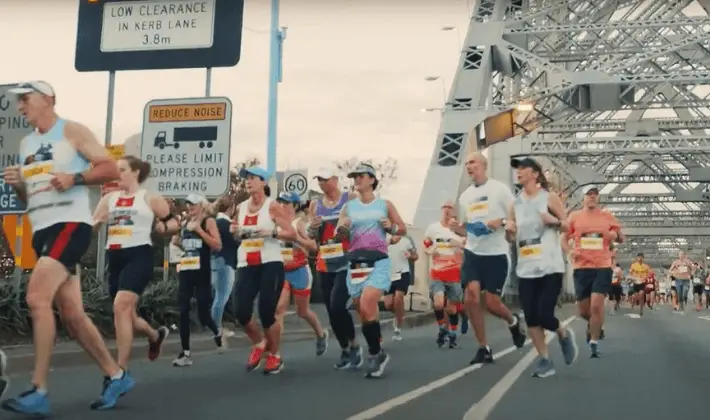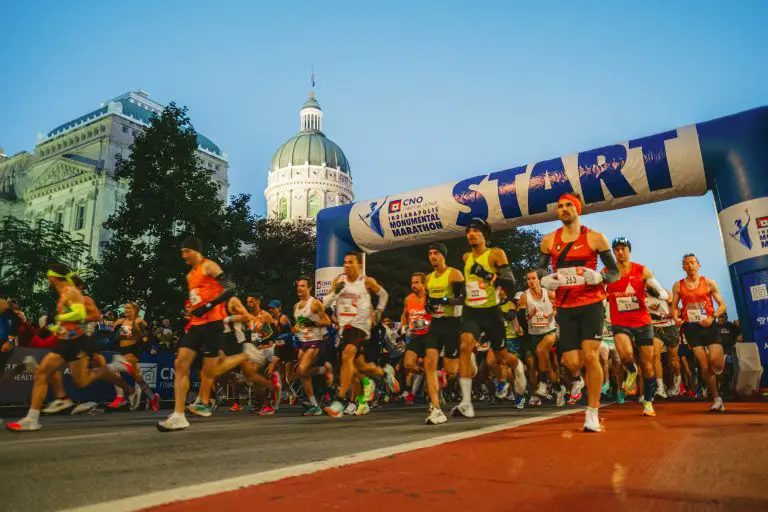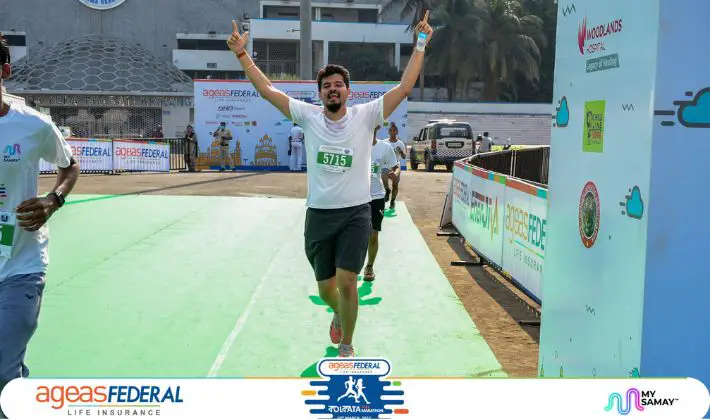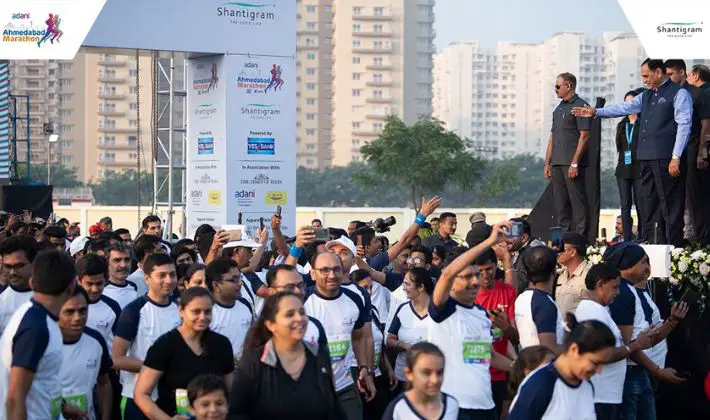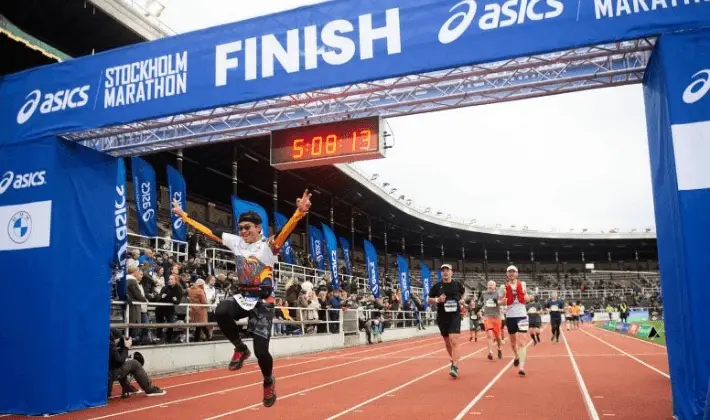Runners Glossary: 100+ Terms Marathoners Need To Know

Running is a popular sport not only because it offers a multitude of benefits, but also because, unlike most other sports, it has a very low bar to entry – you only need comfortable running clothes, good shoes and a place to run. And lately – a new vocabulary as well!
Like any other vocation, over time, running (& runners) have evolved their own language. Words and phrases are tossed around making new runners feel out-of-place.
No worries. I have prepared a list of basic running terms → literally the A. B. C. of Running/ the go-to Running Dictionary.
Aerobic: Aerobic running is when a run is at a sufficiently easy intensity that our respiratory and cardiovascular systems can deliver almost all of the oxygen required by our muscles and avoids lactic acid build up.
Aid station: Any stop along a race route where a runner can pick up water or some other form of aid. Usually set up by race organizer.
Altitude Training: When a runner trains at altitudes above sea level (usually hills/ mountains) to improve their athletic performance. Is advantageous but the effect is short-lived (2-3 weeks) once the runner is back at sea level.
Anaerobic Threshold: Exercise becomes anaerobic when breathing doesn’t provide enough oxygen to meet energy needs. It is the point where the body switches from aerobic (with oxygen) to anaerobic (without oxygen) metabolism. While it is helpful for intense speed workouts that might include intervals/strides, it is also the point where running gets challenging/ tough and lactic acid build up starts happening. Also called Lactate threshold.
Aquajogging: It refers to running in water. Usually done if an athlete is injured since it helps mimic the physical effort while avoiding the negative impact of running on the injury.
Bandit: A person running a race without officially registering or paying the registration fees for the race.
Barefoot running: Some runners run in their bare feet (or with very light shoes) mostly because they believe that running with shoes goes against the natural evolution of the foot.
Base Training: The initial phase in a training program where the goal is to build endurance hence termed as building the “base”.
Beats Per Minute (BPM): Beats Per Minute is the heart rate or the number of heartbeats during a minute. Runners often have a target BPM to get the most out of each workout.
Bib: A sheet of paper containing the registration number and an electronic chip that needs to be attached to the runner’s chest when running a race.
Black Toenails: As the term suggests, these are black toenails with coagulated blood beneath the nails. Can be either caused by direct trauma to the nail or by wearing ill-fitting shoes. Usually, heal on their own but sometimes the nail can also fall off completely.
Bloody Nipples: Men can sometimes suffer from bloody nipples during a run due to the friction caused by rubbing their nipples/chest against the shirt.
Bonk/ Hitting The Wall: Used interchangeably, the words describe the point during a race (or sometimes even a long run) when you run out of energy and feel extreme fatigue – both physical and mental. It can usually be avoided with proper fueling/ nutrition and training.
BQ/ Boston Qualifier: The Boston Marathon is one of the oldest run marathons and has very tough qualifying time standards. A runner needs to achieve the time standard for their age/gender in a qualifying marathon in order to even apply for entry to the Boston Marathon. Running a “BQ” means that a runner has met that qualifying time standard.
Brick Workout: Commonly used by triathletes, Brick workout is a type of workout that includes biking followed immediately by running.
Burnout: A point when a runner feels unmotivated and tired – typically occurs after tough or particularly long training season.
Cadence: The number of steps taken per minute of running. Also known as stride turnover. While optimal running cadence varies depending on height and running mechanics, cadence of 180 steps per minute is considered efficient.
Carb Loading: Loading up on carbs in the days leading to a race to help build the body’s energy store.
Certified Course: A race course that has been reviewed and officially certified by any of recognized associations. Any finishing time on a certified course can be used as a qualifying time for other races.
Chafing: Chafing occurs when clothes repeatedly rub against the skin during a run and usually burns or stings and leave painful rashes. Common areas are body crevices (armpits, under breasts), rubbed by clothing straps (waist, shoulders), areas with sagging skin/ folds and inner thighs. Coating chafing prone areas with anti-chafing creams or vaseline helps.
Chip Time: Majority of the races provide runners with bibs with a small chip attached that automatically tracks not only the start time (when the runner actually crosses the starting line) but also the timing at various points along the course and the finish time.
Compression socks: Usually worn post run to help speed up recovery but some runners wear these during the race as well to improve blood flow and help minimise muscle cramps/ discomfort
Cool-down: Slow running or jogging done after a workout or race to get heart rate & breathing back to normal, loosen muscles and rid the body of lactic acid.
Core / Core training: Core includes the muscles around the middle of your body (abs & back) and play an important role in stability and running form.
Corral: Bigger races often divide runners into groups due to sheer size of the runners. This division is based on their expected finishing time (which is in turn based on timings of past races submitted by the runner). The speediest runners are in the first corral with slower ones at the back. The race bibs usually indicate which corral a runner has been assigned to.
CR: Course Record is the fastest time run on a course of any certified race. For e.g. Geoffrey Mutai of Kenya holds the course record for the Boston Marathon achieved in 2011 with a time of 2:03:02 (Champions | Boston Athletic Association (baa.org)).
Cross Training (XT): All other workouts that a runner might include in their training program to improve overall fitness, prevent injury and as an active recovery alternate to running. Examples include Strength training, cycling, swimming, yoga.
Cushioning: The ability of a shoe to absorb the impact of a footstrike.
DFL: Dead Freaking Last. The last person to cross the finish line.
DNF/ Did Not Finish: The acronym DNF is listed in race results when a racer started the race but did not finish.
NS/ Did Not Start: The acronym DNS is sometimes listed in race results when a racer was registered for a race but did not start. This helps make the distinction between those who didn’t attempt the race and those who attempted the race but were unable to finish.
DOMS: Delayed Onset Muscle Soreness. This type of muscle soreness can occur 24 to 48 hours after a particularly intense or long run.
Drafting: Refers to running behind or slightly to the side of another runner to help avoid the wind resistance
Dreadmill: An alternate name given to treadmill by runners who like running outside and dread running on the treadmill due to inclement weather or time constraints.
Easy Run: Running at a pace where you could easily hold a conversation.
Elite: Professional runners as well as recreational runners who run faster than a certain threshold and have reached the highest level in his/her sport.
Endorphins: This word describes the feel-good chemical that your body releases during and after exercises. Endorphins are what give us the ‘high’ /satisfaction after finishing a run or workout.
Fartlek: Swedish for “speed play”. A training run where effort/ time/ pace/ distance are not set beforehand and can also include uphill and downhill running. The goal of including fartleks into the training program is to include speedwork (without having defined distance/ pace etc) to help improve running performance.
FKT: Fastest Known Time is the speed record for running or hiking routes. Unlike most organized endurance sports events (like marathons), FKTs are usually self organized and done alone or in small groups and usually on trails
FM: Full Marathon. See “Marathon”.
Foam roller: A tube/cylinder with indentations that mimic/provide a deep massage and help in relieving. muscle knots
Foot Strike: The foot strike refers to how the feet hit the ground i.e. which part of your foot first touches the ground – heel strike, midfoot or forefoot/toe.
Form: Refers to how a runner holds his/her body while they run, including position of head, arms, and legs. Good form helps not only to run more efficiently but also helps minimize fatigue and injury.
Front Runner: A runner/racer who is expected to win the race or have a good chance of finishing in a top place.
Fuel: Fuel is nutrition during runs, especially long runs. It can be in various forms, including energy gels, chews, bars, sugary candies, bananas, toast with peanut butter, etc – basically anything which suits your gut and can provide you approximately 100 calories for every 40 to 60min of running.
Fuel Belt: Also known as a hydration belt, a fuel belt is a lightweight belt or pouch where you can safely store a limited amount of running essentials like water, gels, etc. along with mobile, cash etc.
Fun runs: Any run that is more about fun and entertainment than about actual racing. They can be as short as a single mile and are usually used for raising money for charity, giving children something to do or just having fun. ‘la Cursa El Corte Inglés’ is one of the most popular fun runs held annually in Barcelona with over 60k+ participants (42nd El Corte Inglés Race (cursaelcorteingles.cat)).
Gun Time: The official race starting time marked by the point when the clock starts. Usually not the same time as when you actually cross the starting line (see chip time).
Hardware: All the hard-earned race medals!
Hill Repeats/ Hill Sprints: It involves running up a hill at a speedier pace and coming down at a slower pace to allow for recovery. Hill repeats allow runners to engage muscles that are not used as much during flat surface running helping improve both strength and speed.
HM: Half Marathon is a race that goes for 13.1 miles (21.0975 kilometers) which is half the distance of a full marathon.
HR/ HR Zones/ Heart Rate: The number of times your heart beats per minute.Target HR zone is the level of workout intensity based on maximum heart rate. Remaining within target HR zone enables maximum benefits.
HRM: Heart Rate monitor: A device you wear to measure, monitor and display the heart rate continuously. Usually available as a chest strap with electrode sensors that detect and transmit data to a receiver such as a watch or phone app.
Ice Bath: It is a method of recovery used to speed up the body’s healing process after a race.
Intervals: Interval refers to a specific distance that is usually repeated during a speed workout. Runners run these specific distances/ intervals at a quicker pace which is much faster than their usual easy run speed. These are alternated with slower running/ jogging/ walking intervals/periods. Also called ‘Repeats’.
ITBS: Iliotibial Band Syndrome is an injury to the IT band in the leg that runs from the hip, down the thigh, across the knee, and through the shin. Massage, stretching, foam rolling and strength training tend to help.
Jogging: Form of running which is usually a bit slower than actual running.
Junk Miles: Running extra miles at an easy pace to reach weekly/ monthly mileage goals rather than for specific benefit or real workout in mind.
Kick: The final push runners give at the end of a race or training run by increasing their speed to the finish line.
Lactate Threshold: See ‘Anaerobic Threshold’.
Lactic acid: A by-product of metabolizing energy during intense/ anaerobic activities. A buildup of lactic acid can cause muscle fatigue and sore muscles.
LSD/Long Run: Long Slow Distance (LSD) or Long Run covers up to 30% of weekly mileage and usually performed at a slow, comfortable pace to build up stamina. Also known as ‘endurance’ or ‘distance’ run.
Marathon: The most common event for long-distance running, a marathon is a race that goes for 26.2 miles (42.195 kilometers).
Maximalist: Shoes that have a lot of cushioning and support underfoot.
Minimalist: Shoes that are lightweight, have only basic coverage and provide very little support.
MHR: Maximum Heart Rate. Refers to the total number of heart beats per minute during strenuous exercise. Used as a benchmark for determining the relative health of any individual.
Midsole drop: The difference in thickness between the front and back of the running shoe (in millimeters). It is also referred to as heel drop.
Moisture-Wicking Clothing: Unlike cotton, these are especially designed for sports/activity since they help keep the sweat away from the body by bringing it to the fabric’s surface from where it evaporates easily.
MP: Marathon Pace. The pace at which a runner plans’ to run the marathon (or actually runs the marathon). Usually used in few training runs leading to a marathon to prepare for the main event.
MPW: Mileage Per Week/ Miles Per Week. As the name suggests, it is the total mileage you are planning to run / actually run in any given week.
MUT: Mountain/ Ultra/ Trail runner. As the name suggests, a runner who runs on mountains, on trails or runs ultra distances is referred to as MUT.
Out and back: A running route that involves running to a certain point and then running back to the starting point.
Negative Splits: When the second half of the run is faster than the first half. Also, if each subsequent mile is faster than the previous.
Neutral Shoe: Shoes that do not provide any corrective support are termed as neutral running shoes. On the other hand, stability shoes are designed with extra midfoot support.
NR: National Record: Fastest time for any given distance in that country.
Pace: The pace refers to the number of minutes it takes to complete a mile or kilometer. When a runner talks about running a 20 minute 5k, they are referring to their pace. This is different from speed (which tells how many kilometers/ miles you are running per hour).
PB (Personal Best)/ PR (Personal Record): The ‘speediest’ or ‘best time’ of a runner at a specific race distance. For example: “My PB in the 10K is 35:26.”
Personal Worst: it is a runner’s worst time for a specific distance.
Pick-ups: A slight increase in speed for a short duration/ distance towards the end of a run.
Plantar fasciitis: Inflammation of the bottom of the foot which results in pain and stiffness.
Plyometrics: These are dynamic/ bounding exercises that involves series of explosive movements or jumping
Pronation: It is the natural side-to-side motion of the foot as it strikes the ground when we walk or run. Normally, as the weight rolls over the foot, the foot turns inwards. If it rolls too far inward, it is termed as Overpronation. On the other hand, if the foot does not pronate or foot rolls too far outside, it is called Supination or Underpronation. Pronation can be easily checked by looking at the wear & tear on the sole of the running shoes.
Recovery run: A short and slow run at an easy pace which is done within 24hours of a long/ hard run. Helps the body get used to working even in a fatigued state.
Repeats: See ‘Intervals’.
Rest Day: An important part of a runner’s training plans to help the body adapt to the training stress through sleep, proper nutrition and active recovery.
RHR: Resting Heart Rate. It is the number of times your heart beats per minute while at complete rest. It is an indicator of good health. Resting heart rate decreases as your heart becomes stronger through aerobic exercise.
RICE: Rest, Ice, Compress, Elevate. Regimen is sometimes recommended by doctors to treat sports injuries. Rest – Immediately rest the affected area; Ice – To help reduce the pain and swelling during the first 48hrs of injury; Compression- Use medical bandage to wrap injured area; Elevate- Keep the injured body part raised as much as possible.
Ride: ‘Ride’ is referred to in terms of shoes i.e. the ability of the running shoes to provide a smooth transfer of a runner’s weight from heel-strike to toe-off. A shoe having a smooth ‘ride’ is largely a subjective thing but most runners usually know it when a shoe provides a good ride.
Runner’s high: The feeling of ‘euphoria or a high’ a runner reaches during or after a run or an intense exercise.
Runner’s Knee: A common running injury where the runner experiences pain on or around the kneecap. Also called Patellofemoral Pain Syndrome (PFPS).
Running economy: Refers to how much oxygen is used when we run. When we improve your economy, we are able to run at a smaller percentage of max VO2.
Run/walk: For novice runners/ beginners, a Run/Walk is the ideal way to initiate running. It involves alternating between gentle slow runs with alternative periods of walking. For e.g. R1W2 means Run 1 min/ Walk 2 min.
Shin Splits: Another common injury for runners, experienced as pain on the inside of the lower leg/ shin area. Usually experienced when runners increase distance drastically or increase pace too quickly. Speedwork: Any workout that is specifically focused on running at a faster pace/s e.g. intervals, tempo, fartleks, hill training, etc.
Split Time: The time it takes you to cover a specific distance during training or a race. It can also mean the breakdown of a long race into shorter sections. An “even split” means you ran roughly the same speed the entire time. A “negative split” is when you get faster in the second half of the run.
Sports Watch: Sports watches are GPS enabled watches that help plan running routes, track the distance as well as speed. They also provide feedback on heart rate, sleep cycle, etc.
Streaker: Streaking is usually when you run consecutively for days (e.g. HDOR – Hundred Days Of Running). It can also mean participating, annually, in the same race.
Strength Training: Training for strength which usually involves dumbbells/ weights or bodyweight exercises to improve muscle strength in order to help avoid injuries.
Stress Fracture: These are small cracks in the bone due to overtraining/ excessive training. These are not true breaks but if activity is not stopped/ abated, it can lead to actual bone fracture.
Strides: Strides are short ~30 sec or 50-150 meters bursts of speed where you gradually accelerate up to 90% of your maximum speed.
Stretching: Stretching can be either Dynamic (a range of motions/movements which are light & bouncy to warm-up the body before running) or Static (When you ‘hold’ a position at the end range of motion/movement- usually done at end of workout).
Talk test: A talk test is a way to check if your easy run is really easy or are you pushing yourself too hard. If you able to hold a conversation while running, you are running at an easy pace.
Taper: Refers to the last few days leading upto race when the training is complete and you cut back on the mileage for the body to rest / rejuvenate for the final race day. The length of taper depends on the distance you have to race. Longer the distance, longer the taper.
Tempo Run: A type of run where the runner has to run a set time or set distance at a challenging pace only slightly slower than race pace. It is built into the training plan to help practice maintaining speed over a period of time.
Ten Percent Rule: A often-used rule used when runners’ are trying to increase their weekly mileage. Basically means that increase in mileage week-on-week should not be more than 10% of the previous week to avoid injury
TM: Treadmill.
Trail Run: As the name suggests, this is running on a trail in a natural setting. More interesting but also more challenging due to the uneven terrain. Runners prefer wearing trail shoes for greater traction and stability.
Triathlete: Athletes who run, swim and bike in one race i.e. participate in Tri/triathlons.
Ultramarathon: An ultramarathon has no set distance – it is simply any race that extends more than 26.2 miles. There are also 24-hour races, in which the competition is to see who can run the farthest in a single day.
VO2MAX: Maximum (Max) Rate (V) of Oxygen (O2). The maximum oxygen uptake (VO2 max) tells how efficiently the body can use oxygen during exercise.
Warm-up: Initial part of a workout to help get the heart rate up and increase the blood flow to the muscles. It can include dynamic stretches, running drills and jogging.
WR: World Record: Fastest time in the world run at any given distance. The current world record for marathon is held by Eliud Kipchoge of Kenya in the Berlin Marathon achieved in 2018 with a time of 2:01:39 (BMW BERLIN-MARATHON: Results Archive (bmw-berlin-marathon.com)).
XC: Cross Country: When teams/ individuals run a race on open-air courses over natural terrain – surface may include grass or dirt and course might pass through flat ground, hills, woodlands and open country.
XT: See Cross training.

